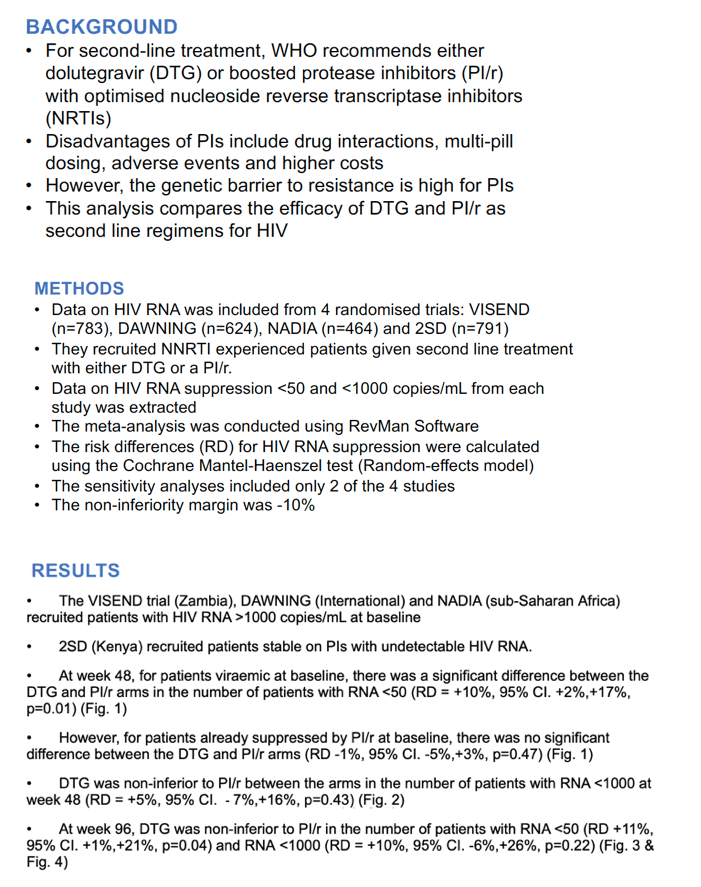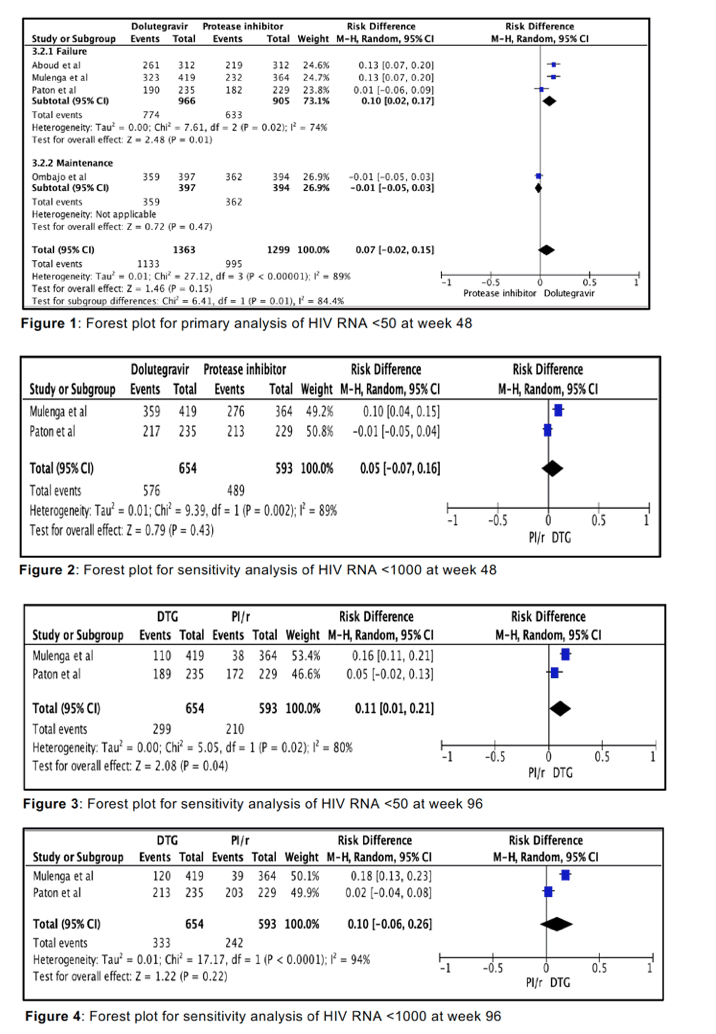 |
 |
 |
| |
DTG Superior or Noninferior to PI/r After NNRTI Failure: Meta-Analysis of 4 Trials in Africa: VISEND, DAWNING, NADIA, 2SD
|
| |
| |
HIV Drug Therapy Glasgow, October 23-26, 2022
Mark Mascolini
Meta-analysis of four large randomized trials determined that dolutegravir (DTG) is superior or similar to a boosted protease inhibitor (PI/r) in suppressing a detectable HIV load after first-line nonnucleoside (NNRTI) failure [1]. In a sensitivity analysis of two trials, DTG was noninferior to PI/r in attaining an undetectable viral load.
Researchers at Imperial College London and colleagues at other centers noted that World Health Organization antiretroviral guidelines recommend DTG or PI/r as the key drug in a second-line regimen after an NNRTI has failed. PI/r has the advantage of a high barrier to resistance, they added, but at least four disadvantages-drug interactions, multipill dosing, side effects, and higher costs.
To help clinicians decide whether to opt for DTG or PI/r after first-line NNRTI failure, these investigators combined data from four randomized trials of these two second-line strategies: VISEND in Zambia had 783 participants [2], the international DAWNING trial gathered 624 participants [3], and NADIA in sub-Saharan Africa had 464 participants [4]. A fourth trial, 2SD, enrolled 791 people in Kenya with an undetectable viral load while taking a stable second-line PI regimen and randomized them to continue that regimen or switch to DTG [5]. Together, the trials assessed virologic responses in 2662 participants.
The researchers extracted and combined data on proportions of participants reaching a viral load below 50 or 1000 copies 48 or 96 weeks after switching to DTG or PI/r, or maintaining a suppressive PI/r regimen. They performed a meta-analysis of these results and determined the risk differences for viral suppression. A sensitivity analysis focused on 2 of the 4 trials.
VISEND, DAWNING, and NADIA recruited participants with a viral load above 1000 copies while taking a failing NNRTI combination. 2SD recruited people with an undetectable viral load while taking a PI/r combination after NNRTI failure. After 48 weeks in VISEND, DAWNING, and NADIA, the DTG regimen pushed viral loads below 50 copies significantly more often than PI/r (risk difference +10%, 95% confidence interval [CI] +2% to +17%, P = 0.01). But in 2SD participants, who had an undetectable viral load on their PI/r combination when the trial began, there was no significant difference between staying with PI/r and switching to DTG (risk difference -1%, 95% CI -5% to +3%, P = 0.47).
In a combined analysis of VISEND and NADIA results, DTG proved noninferior to PI/r in the proportion of participants with a viral load below 1000 copies at week 48 (risk difference +5%, 95% CI -7% to +16%, P = 0.43). At week 96 in the same two trials, DTG was noninferior to PI/r in proportions of participants with a viral load below 50 copies (risk difference +11%, 95% CI +1% to +21%, P = 0.04) and viral load below 1000 copies (risk difference +10%, 95% CI -6% to +26%, P = 0.22).
The researchers concluded that DTG was either superior to or noninferior to PI/r in getting viral loads below 50 or 1000 copies at week 48 or 96 in trial participants in whom an NNRTI regimen had failed.
References
1. Mirchandani M, Qavi A, Simmons B, Hill A. Meta-analysis of efficacy for DTG versus PI/r as second-line treatment in 4 randomised trials, 2662 participants. HIV Drug Therapy Glasgow, October 23-26, 2022. Abstract P062.
2. Clinical Care Options HIV. VISEND: Switching From NNRTI-Based to PI-Based ART vs DTG + Recycled NRTIs Source: Conference Coverage of CROI 2022: Clinical Impact of New HIV Data. February 13-16, 2022; Virtual. https://www.clinicaloptions.com/hiv/conference-coverage/2022/retroviruses-2022/clinical-impact-of-new-hiv-data/capsule-summary-slidesets/135
3. Aboud M, Kaplan R, Lombaard J, et al. Dolutegravir versus ritonavir-boosted lopinavir both with dual nucleoside reverse transcriptase inhibitor therapy in adults with HIV-1 infection in whom first-line therapy has failed (DAWNING): an open-label, non-inferiority, phase 3b trial. Lancet Infect Dis. 2019;19:253-264. doi: 10.1016/S1473-3099(19)30036-2. https://www.thelancet.com/journals/laninf/article/PIIS1473-3099(19)30036-2/fulltext
4. Paton NI, Musaazi J, Kityo C, et al. Efficacy and safety of dolutegravir or darunavir in combination with lamivudine plus either zidovudine or tenofovir for second-line treatment of HIV infection (NADIA): week 96 results from a prospective, multicentre, open-label, factorial, randomised, non-inferiority trial. Lancet HIV. 2022;9:e381-e393. doi: 10.1016/S2352-3018(22)00092-3. https://www.thelancet.com/journals/lanhiv/article/PIIS2352-3018(22)00092-3/fulltext
5. ClinicalTrials.gov. Second-line switch to dolutegravir study (2SD). ClinicalTrials.gov identifier NCT04229290. https://clinicaltrials.gov/ct2/show/NCT04229290



|
| |
|
 |
 |
|
|